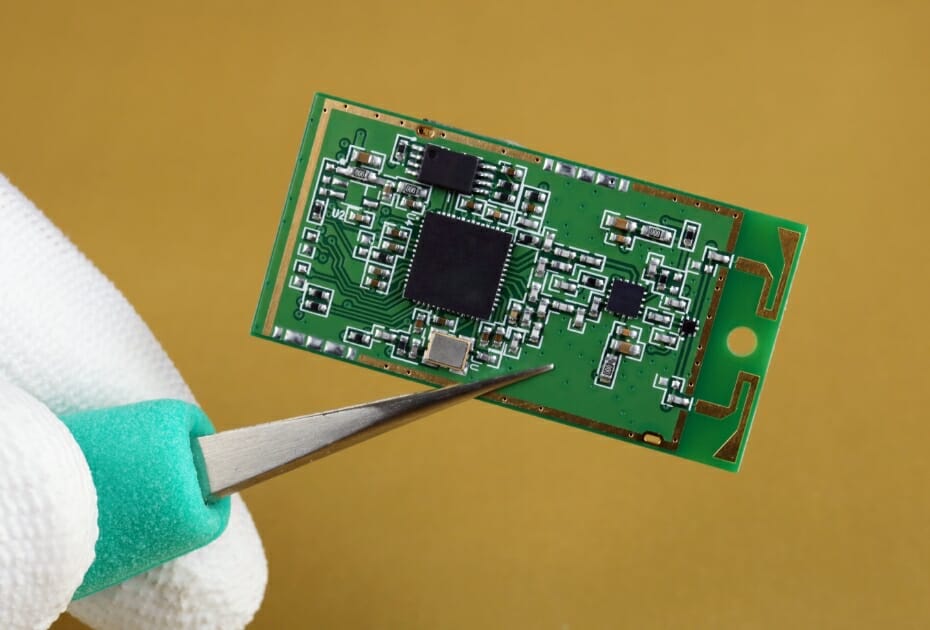

Identifying the Correct Crystal Oscillator for Bluetooth Applications
You’re probably already very familiar with Bluetooth technology from using it on your phone, car stereo, and other devices. This technology is what allows two different devices to exchange data between them. For instance, you can stream your Spotify playlist on your smartphone to your car stereo using Bluetooth technology. Another popular example is how Bluetooth allows us to sync a pair of wireless headphones with our smartphones.
Since Bluetooth was developed back in the late 1990s and improved over time, it has been steadily changing the way that we communicate, consume media, transfer information, listen to music, and much more.
How Does Bluetooth Work?
Bluetooth technology uses a wavelength to transmit information; however, it only works over short distances. You may have noticed that if you are wearing wireless headphones and walk too far away from your smartphone, the signal either gets disrupted or is cut off altogether.
Bluetooth waves aren’t meant to travel very far. In fact, most Bluetooth devices have a maximum connectivity range of around 30 feet. That distance can be cut even shorter if there are obstacles between the two devices connected via Bluetooth.
The Bluetooth standard has changed many times over the years, from Bluetooth 1.1 in 2002, Bluetooth 2.0 EDR (Enhanced Data Rates), the Bluetooth 3.0 HS (High Speed and Ultra-Wideband), to today’s Bluetooth 5.1 with direction and asset-tracking services.
What’s interesting about Bluetooth connectivity is that it operates on varying frequencies. Bluetooth connectivity is safe and secure from hacking because the frequencies change hundreds of times per second. This is known as frequency hopping spread spectrum.
Types of products that have Bluetooth capability:
- Smartphones
- Speakers
- Headphones/earbuds
- Computers/tablets/laptops
- Smart watches
- Camera systems
- Lighting systems
- Security systems
- Other consumer electronics
Building Out Bluetooth: Considerations to Make When Choosing Crystal Oscillators and Electronic Components Online
When creating a circuit design, engineers need to account for variables such as clock jitter, signal noise, and signal propagation delays. Taking the system scale into consideration, it’s important to remember that the RAM and CPU requirements can be demanding for an embedded system. A significant amount of processing power from the CPU is required when using an angle estimation algorithm.
The vast majority of Bluetooth circuit designs utilize a 32 MHz crystal because it provides excellent tolerance and stability. However, there are other Bluetooth designs that use 16 MHz (Nordic Semi), 38.4 MHz (SiLabs), and 26 MHz. Bluetooth is a huge market, and ECS Inc. leads the industry in terms of electronic components online they can choose from.
The following is a complete list of 32 MHz crystals and oscillators offered by ECS Inc. that can be used for Bluetooth applications, LoRa, and other wireless protocols.
Crystals
ECS-320-10-30B-CKM-TR, ECS-320-10-33-AGM-TR, ECS-320-10-33-JTL-TR
ECS-320-10-33B-7KM-TR, ECS-320-10-33B-CKM-TR, ECS-320-10-36-CKL-TR
ECS-320-10-36-CKM-TR, ECS-320-10-36-CTN-TR, ECS-320-10-36-JGN-TR
ECS-320-10-36B-7KM-TR, ECS-320-10-36B-CKM-TR, ECS-320-10-36B-CTN-TR
ECS-320-10-36B-CTN-TR, ECS-320-10-36B2-CKM-TR, ECS-320-10-36B2-CTN-TR
ECS-320-10-36Q-AES-TR, ECS-320-10-36Q-ES-TR, ECS-320-10-37-CHN-TR
ECS-320-10-37-CKM-TR, ECS-320-10-37-CKM-TR3, ECS-320-10-37-CWN-TR
ECS-320-10-37-CWN-TR3, ECS-320-10-37B-7TN-TR, ECS-320-10-37B-CKY-TR
ECS-320-10-37B-CTN-TR, ECS-320-10-37B2-CKY-TR, ECS-320-10-37B2-CWN-TR
ECS-320-10-37B2-CWN-TR, ECS-320-10-37B2-CWN-TR, ECS-320-10-37BQ-CKY-TR
ECS-320-10-37Q-ES-TR, ECS-320-10-48B-CKY-TR, ECS-320-10-48B-CKY-TR
ECS-320-12-33-AGM-TR, ECS-320-12-33-AGN-TR, ECS-320-12-33B-7KM-TR
ECS-320-12-33B-CKY-TR, ECS-320-12-33Q-JEN-TR, ECS-320-12-33Q-JES-TR
ECS-320-12-36-CKM-TR, ECS-320-12-36B-CKY-TR, ECS-320-12-36B-CTN-TR
ECS-320-12-36B-CWN-TR, ECS-320-12-36B2-CKY-TR, ECS-320-12-37-CKM-TR3
ECS-320-12-37-CWN-TR, ECS-320-12-37B2-7KM-TR, ECS-320-13-42-CKM-TR
ECS-320-16-33B-CKM-TR, ECS-320-18-30B-AGN-TR, ECS-320-18-33-JEM-TR
ECS-320-18-33-JGN-TR, ECS-320-18-33Q-DS, ECS-320-18-33Q-DS
ECS-320-20-20A-F-TR, ECS-320-20-30B-DU, ECS-320-20-30B-TR
ECS-320-20-33-CKM-TR, ECS-320-20-33-DU-TR, ECS-320-20-33-TR
ECS-320-6-36B-CTN-TR3, ECS-320-6-37-JTN-TR, ECS-320-6-37B-CKY-TR
ECS-320-6-37B-CTN-TR3, ECS-320-6-37B2-CKM-TR, ECS-320-6-37B2-JTN-TR
ECS-320-6-47B-CKY-TR, ECS-320-6-47Q-CTN-TR, ECS-320-7-48B-JTM-TR5
ECS-320-8-30B-CKM, ECS-320-8-33-JGL-TR, ECS-320-8-33-RWM-TR
ECS-320-8-33-RWY-TR, EECS-320-8-33B-7KM-TR3, ECS-320-8-33Q-JES-TR
ECS-320-8-36-RWN-TR, ECS-320-8-36B-7KM-TR, ECS-320-8-36B-CKY-TR3
ECS-320-8-36B2-CKM-TR, ECS-320-8-36B2-CKY-TR, ECS-320-8-36CKM-TR3
ECS-320-8-36Q-CWY-TR, ECS-320-8-37-CKM-TR3, ECS-320-8-37B-7KM-TR3
ECS-320-8-37B-7KY-TR, ECS-320-8-37B-CKY-TR3, ECS-320-8-37B-CTN-TR
ECS-320-8-37B-CWY-TR3, ECS-320-8-37B2-7KM-TR, ECS-320-8-37B2-CKM-TR
ECS-320-8-37B2-CKY-TR, ECS-320-8-37B2-CTN-TR, ECS-320-8-37B2-CWY-TR
ECS-320-8-37BQ-CKY-TR, ECS-320-8-47-CKM-TR3, ECS-320-8-47-JTN-TR
ECS-320-8-47B-7KM-TR, ECS-320-8-47B-7KY-TR, ECS-320-8-47B-CKY-TR
ECS-320-8-47B-JTM-TR, ECS-320-8-47Q-CES-TR, ECS-320-8-48B-CKY-TR
ECS-320-9-33B-CWN-TR3, ECS-320-9-47Q-CKM-TR, ECS-320-CD-0298-TR
ECS-320-CDX-1328, ECS-320-CDX-2094, ECS-320-CDX-2152
ECS-320-S-20A-TR, ECS-320-S-30B-TR, ECS-320-S-33-TR
Oscillators
ECS-3225MV-320-BN-TR3, ECS-3225MV-320-CN-TR3, ECS-3225MVQ-320-BP-TR,
ECS-3225MVQ-320-CN-TR, ECS-3225S33-320-FN-TR, ECS-3518-320-B-TR
Search ECS Inc. Inventory of Electronic Components Online
By copying and pasting the ECS Inc. part number into the search fields of our search inventory page, you can find specific crystals and/or oscillators for your Bluetooth application. Additionally, if you need help finding the correct electronic components online for your application, you can always contact us for engineering support. Our engineering team will review the specs of your Bluetooth application and determine the best crystal oscillator or other timing solution for your project.
ECS, Inc. Electronic Components Online
If you are looking for frequency control solutions for their timing, reliability, and performance, ECS, Inc. carries the following timing solutions.
Some of the most popular solutions our customers use include surface mount oscillators, programmable oscillators, AEC-Q200 crystals, 32.768 kHz crystal tuning forks, and real time clocks (RTC).
Our parametric search allows you to locate specific components by stability, size, temperature range, resonance frequency, tolerance, mounting type, and other attributes.
Our search tool makes it easy to find an ECS Inc. sales representative in your area. As a global supplier of advanced passive components and timing solutions, ECS Inc. International has a vast network of authorized distributors.
What Kind of Crystal Do I Need for Bluetooth Compatibility? was last modified: February 14th, 2023 by